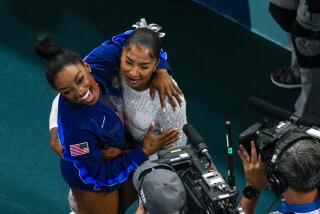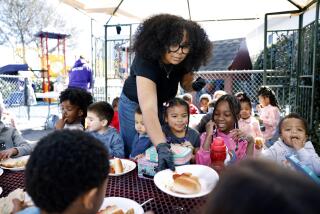Kiddie Gyms Have Come of Age : Popularity Soars Despite Health Concerns for Youngsters
Five-year-olds wear fashionable leotards and sweat suits at My Gym in Woodland Hills. A heavy beat of disco music throbs from stereo speakers. The place looks like a miniature Holiday Health Spa or Sports Connection.
During a Wednesday afternoon class, the children struggle to keep up during an aerobics workout. They flop and bounce across the gym mat, flailing through kicks and stretches and bends.
“Keep your body straight!” the instructor, a young woman, shouts in sing-song voice. “Here we go! And take a deep breath . . . and let the air out!”
There are a half-dozen “kiddie gyms” like this in the San Fernando Valley, health clubs that cater to children from infancy to age 7. These clubs sprang up in the wake of the adult fitness craze. The children come to huff and puff through workouts of stretching, aerobics and tumbling.
And while medical authorities ponder the effects of such exercise on youngsters, kiddie gyms grow increasingly popular, with $10-an-hour classes filled to capacity.
“Youth fitness is the big void in this country. It is believed that this will be the big push in the next years,” said Fritz Reiter, whose Gymnastics Olympica USA in Van Nuys offers “Kindergym” workout classes. “The adults are in better shape than the children. That’s not right.”
On Reiter’s desk lies a pamphlet from an Iowa company that sells elaborate weight-training machines designed for prepubescent children.
“There is a craze here,” said Yakov Sherman, whose My Gym operates clubs in Woodland Hills and Van Nuys. “It definitely has to do with an overall trend toward being fit. We are raising a better person, a better generation of children by being healthier.”
Young children always have taken tap dance or ballet lessons. Local YMCAs offer “Mommy and Me” infant exercise classes. And there are growing numbers of gymnastics schools that will start children on their way to the Olympics at an early age.
But at kiddie gyms, preschoolers exercise for exercise’s sake. These scaled-down health clubs chart new and unusual territory in the world of fitness.
Doctors and researchers say they aren’t convinced that’s such a good thing. They agree that there are positive aspects to children’s exercise programs. But, they say, there can also be a negative side.
“I certainly would not advocate that all exercise programs be stopped or that exercise programs have no value. But we do have concerns about any regimented exercise involving children,” said Joan Mehn, former director of physical and occupational therapy at Childrens Hospital in Los Angeles. “Exercise programs do not have to be structured. Young children need to explore in a more unstructured way.”
Sandi Dennis, Mehn’s colleague at the hospital, recently visited several Los Angeles kiddie gyms while researching the effects of aerobics on children. She said some workout classes did not provide adequate time for stretching. Others she saw were not equipped with proper matting over the gym’s concrete floors. And, she said, instructors were not always adequately educated in anatomy, physiology and child development.
Among Valley instructors, the degree of education varies. Sherman, of My Gym, was educated in dance therapy. Dave Rabb, who owns Gym for Children in Tarzana, holds a bachelor’s degree in physical education. Reiter, who has coached gymnastics for 20 years, studied architecture at Technical University of Vienna.
“I’ve seen some very good gyms that have very well-designed exercise programs and I’ve seen other ‘kidnastics’ that I feel are doing more harm than good,” Dennis said.
Neither Dennis nor any doctor interviewed could recall treating injuries from kiddie gyms. (As a safety measure, most gyms provide one instructor for every three or four children on the mat.) But doctors did question some of the claims being made by kiddie gyms.
The My Gym pamphlet advertises that its program “not only enhances essential physical skills, but also increases the child’s self-esteem.” Reiter’s Olympica USA purports to “improve their coordination and other motor skills.”
Accepted studies show that coordination develops along a natural timetable that can’t be accelerated by any amount of calisthenics or agility exercises, Mehn said.
“I’m skeptical as to the value of teaching those skills at that age,” concurred Ronald MacKenzie, medical director of the National Athletic Health Institute at Centinela Hospital in Inglewood. “I would be terribly surprised if it contributed anything substantial to health. To get kids to exercise, you don’t have to put them in class, you just have to play with them.”
Kiddie gym owners concede that children don’t have to work out in a gym to be healthy. But Rabb, who started the trend in Los Angeles a decade ago with his gyms in Culver City and Tarzana, argued that city kids need a little help growing up fit.
“Certainly in Iowa, in the middle of the farm belt, you wouldn’t have a gym like this,” Rabb said. “There, the kids are walking to school, climbing on tractors. They’re having fun throwing a ball through a hoop in a barn.”
And despite doctors’ comments about coordination development, Lloyd Wiltfong, the program administrator at Olympica USA, stuck by his gym’s claim that structured exercise improves children’s agility and coordination.
“I’m not a scientist, but providing this development has got to lead to a greater potential for physical growth,” Wiltfong said.
During recent visits to several kiddie gym classes in the Valley, the children appeared to enjoy themselves. The instructors were patient and worked well with their charges.
At such young ages, the children were not eloquent in praising club workouts. The best that Delaney Menell, 5, of Hidden Hills, could muster was, “I love My Gym.”
“My child is passionate about this place,” said Delaney’s mother, Margee. “This is the biggest love of her life. This is my joy to come here one day a week and watch her be so happy.”
The classes at most kiddie gyms follow a similar pattern. The children usually begin by saying hello to each other and singing a song. After that comes stretching and aerobics and tumbling. At a recent Gym for Children class, the instructor taught the kids a basic tumbling maneuver.
“It’s not a cinnamon roll. It’s not a dinner roll,” he said. “It’s a forward roll!”
Clubs like Olympica USA and Le Club Gymnastics and Fitness Center in Northridge stress a gymnastics approach to working out. The children walk on balance beams and swing from uneven bars. At My Gym and Gym for Children, similar exercises are conducted on playground-like equipment: monkey bars and slides and swings. Many of these exercises are disguised as games.
Rabb said he thinks this type of workout gives children the coordination it takes to play on a jungle gym or swing set with assurance and ease.
“They can go out in the playground and do what they want,” Rabb said. “There are many people who have gone through life without learning to skip. You couldn’t give a child anything better than confidence.”
Confidence and self-assurance are words that kiddie gym owners use often. They say children are more comfortable in the casual atmosphere of their clubs than in competitive ballet or gymnastics classes.
“We don’t have any failures in this gym. Every child is capable,” Sherman said. “We encourage the children to say, ‘I can do it.’ Not that they are going to do it better than anybody else, but as good as they can.”
And Dennis, of Childrens Hospital, agreed that a pleasant experience in the gym can get children in the habit of exercising.
“Certainly it does promote an active life style and that’s going to have a positive effect in the long run,” she said.
The parents who bring their children to kiddie gyms said they are sold on the idea.
“Kids at this age are usually stumble bums. She’s so coordinated it’s crazy,” said Beth Taylor of Tarzana, pointing to her 3-year-old daughter Jamie, who has been coming to classes for 2 1/2 years. “And it’s something to do with them besides sitting around the house or walking in the park.”
Elaine Tominaga, a Calabasas schoolteacher, thought the gym would be perfect for her son Kevin, who was just starting elementary school.
“He’ll learn motivation plus the ability to listen and follow instructions,” she said. “I bet this is better preparation for school and reading than anything.”
Most parents interviewed said they regularly worked out at an adult health club. Kiddie gym owners say the popularity of adult health clubs paved the way for their gyms.
“There was not the awareness before of how good it is for kids to start these things at a young age,” Sherman said. “If you compare me at five years old to these children . . . these children are superstars.”
Like Sherman, Reiter is convinced that kiddie gyms will produce a happier, healthier generation.
“That is the greatest thing there is,” Reiter said. “You prepare a body that runs better.”



